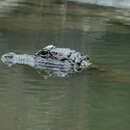Biology
(
Inglês
)
fornecido por Arkive
Inhabiting temperate regions, the Chinese alligator spends the winter hibernating in complex underground burrow systems (4). Alligators emerge as the days begin to heat up in May and nesting occurs from July to August (4). Females reach sexual maturity at 4 - 5 years old and lay about 10 - 50 eggs per clutch on mound-nests constructed from plant materials (2).
Alligators hunt at night and the Chinese alligator's diet consists mainly of aquatic molluscs such as snails and mussels as well as fish (2); incidental waterbirds and small mammals are also taken (6).
Conservation
(
Inglês
)
fornecido por Arkive
In contrast to the decimated wild population, the breeding of captive Chinese alligators has been very successful and the captive population currently exceeds 10,000 individuals (2). The Anhui Research Centre of Chinese Alligator Reproduction (ARCCAR) was established in 1979 and houses captive-bred alligators within 26 small protected reserves (2). Any wild populations that remain are severely fragmented and almost none exist in their natural habitat (2). However, the Chinese government has recently allocated funds to create new habitats with a view to introduce captive-bred alligators into the wild in three other provinces (2). This encouraging step needs the support of local people to make it a success; they will need to be convinced of the worth of living together with this ancient species that may have been associated with the mythical Chinese dragon.
Description
(
Inglês
)
fornecido por Arkive
The Chinese alligator is one of the smallest crocodilians (a group that also includes crocodiles, caimans and the gharial) and one of the most endangered (2). The stocky body is covered in hard scales on the back, softer scales on the sides and belly, and is a dark green/black colour. Up to 17 transverse rows of 6 bony scales run along the length of the body, with paired ridges running halfway down the tail and converging into a single ridge that terminates at the end of the tail (5). In addition to its smaller size, the Chinese alligator can be distinguished from its American relative (Alligator mississippiensis) by a slightly upturned and more tapered snout and from bony plates on each upper eyelid (2).
Habitat
(
Inglês
)
fornecido por Arkive
Originally found in slow-moving riverine and swampy areas, low-elevation agricultural communes and tree farm communes up to 100 m above sea level (4). Now the only remaining wild populations exist in agricultural pools within reserves (6).
Range
(
Inglês
)
fornecido por Arkive
Once widely distributed throughout the eastern Yangtze River system in China, this species is today mostly restricted to a 433 km² reserve in the Anhui province of the lower Yangtze (2). Although reintroduction efforts in three other provinces in eastern China are currently underway (6).
Status
(
Inglês
)
fornecido por Arkive
Classified as Critically Endangered (CR - A1c, D) on the IUCN Red List 2002 (1), and listed on Appendix I of CITES (3).
Threats
(
Inglês
)
fornecido por Arkive
A survey by the Wildlife Conservation Society in 1999 found the wild population of Chinese alligators to be worryingly low: at 130 to 150 individuals (2). Habitat destruction has been the major cause of this decline, and wetland areas continue to be modified for agriculture in an effort to cope with the intense human population pressure in the region (4). A highly secretive species, spending a long period of time (6-7 months) below ground in burrows, the Chinese alligator now primarily exists in populated areas where it inevitably comes into conflict with local farmers. Burrow systems cause drainage problems for fields and alligators also consume ducks owned by farmers (2). Despite a lack of commercial value for the Chinese alligator's skin on the international market, these reptiles are often killed when encountered either through fear or due to a threat to livelihood (2).

